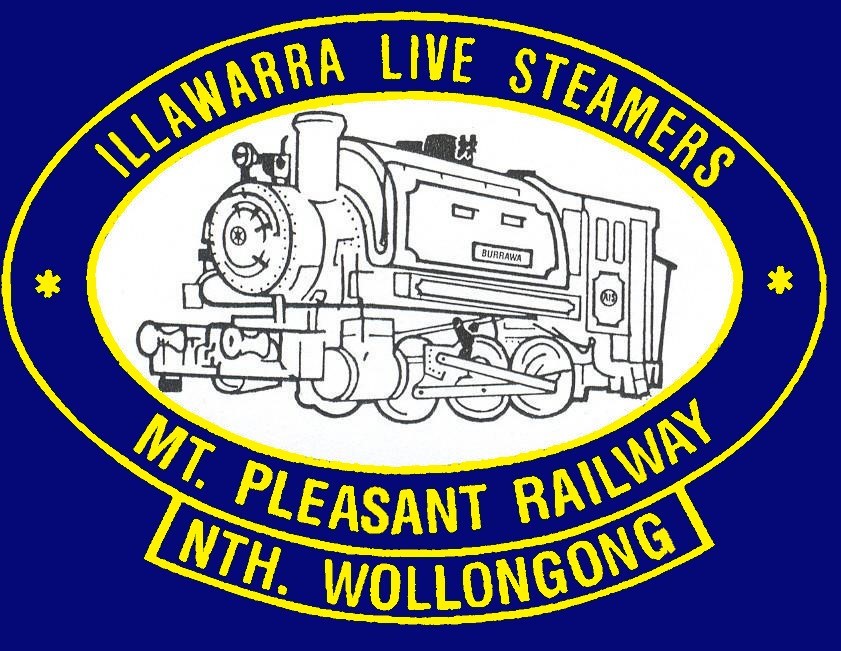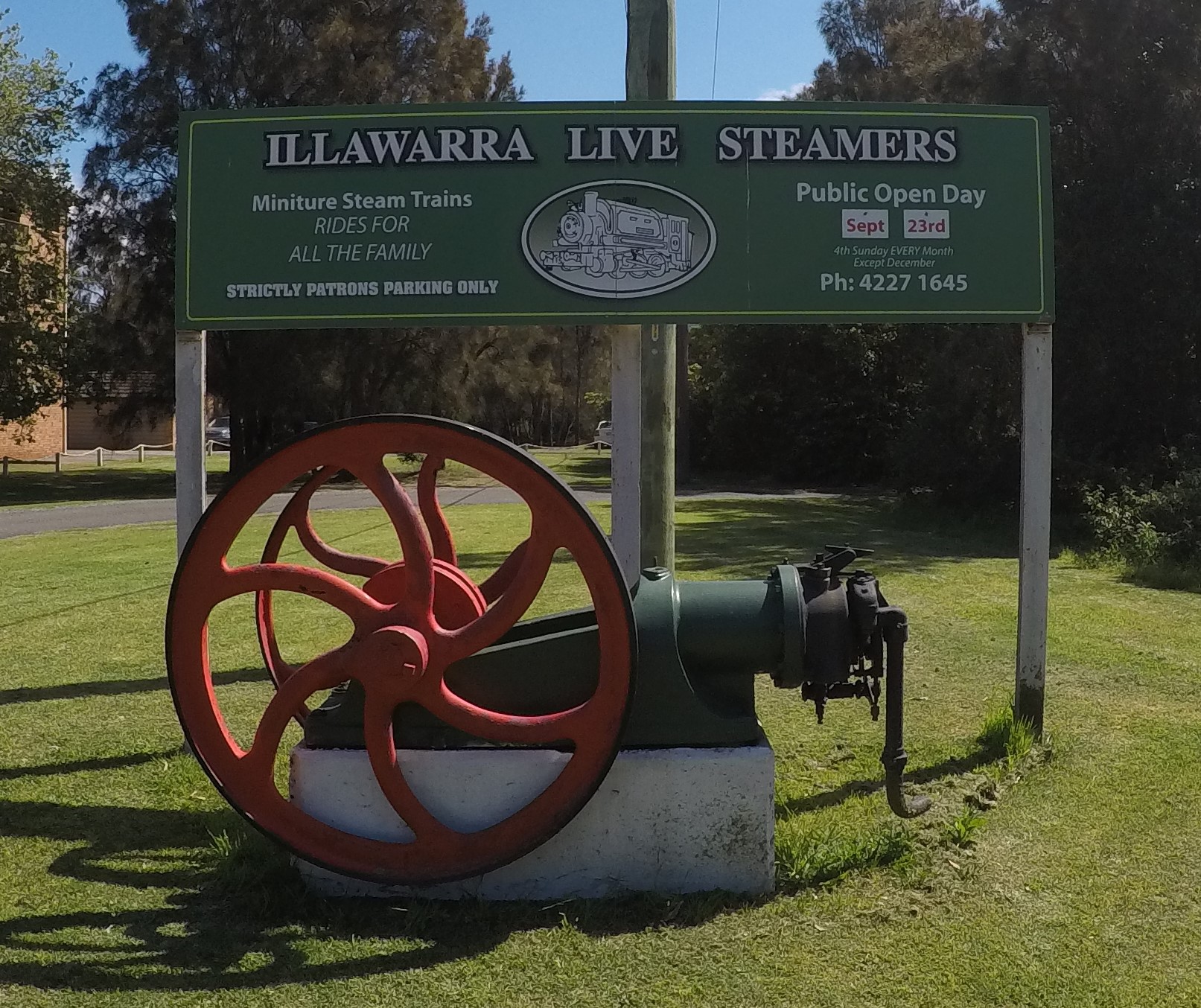

A Brief History
In the early 1960's a number of model steam train enthusiasts banded together to form a club to promote model engineering in general and the construction and operation of live steam locomotives, road vehicles and plant. They were a loose band of members with informal meetings being held from time to time and it wasn't until 1964 before formal meetings were held the first record of the proceedings being kept by the Hon. Treasurer.
It was through one of these members that a site was obtained at the West Wollongong Workers Bowling Club in Phillip Street, West Wollongong and it was here that our history commenced.
With somewhere to call home, it was at one of those early unrecorded meetings that the motion to erect an elevated track was discussed and agreed to with the money and materials being donated by the members resulting in the erection of an elevated track of some 460 feet in circumference. (The elevated track is still in operation at our new home in Stuart Park.)
A review of the minutes of the 1965 August General Meeting revealed that the cost of a ride was the princely sum of sixpence (five cents).
The next construction job was the erection of a shed on the western side of the station and in due course it affectionately became known as 'The Lobby'. Not only was it used for storage of the equipment but also used as a 'meal room' on work/running days. The steaming and unloading bays were, later on, constructed on the northern side of the track.
The next major project to be undertaken was the construction of another elevated track due to the lay of the land. The new track was of some 1300 feet in length and encompassed the building of two large bridges over an often swollen creek and a smaller bridge over the existing elevated track as well as some extensive earthworks on the embankments. To assist in the financing of the project, small copper plates were produced and for the sum of 50 cents ones name would be stamped thereon and affixed to a sleeper. This track was completed in 1969 and a pedestrian overbridge was then constructed to allow public access onto the grounds in the centre of the elevated tracks.
Prior to the formation of the Australian Association of Live Steamers (AALS) the members decided to host the 1972 Convention over the Easter period. The Convention was a great success both engineering wise and socially, however the heavens opened up on Saturday night which put a damper on the events for Sunday and Monday.
Another major project completed prior to the staging of the Convention was the construction of the toilet block and the erection of other steaming bays.
Due to the acquisition and storage of extra equipment in The Lobby, the members decided to erect a 24' x 12' shed to store this equipment and retain The Lobby as a meal/meeting room. Later on, to assist the members in the storage of their passenger wagons a carriage shed was added to the storage shed
Since the early 1960's Hobbies Exhibitions and Miniature Railway Displays were part of the family scene and our Club was to the fore and a regular participant at these functions. During the mid 1970's, our club had arranged a display at the Wollongong High School and a couple of members returned to the club grounds to obtain some more equipment. On arrival, they noticed that surveyors were busily engaged in surveying the ground and upon enquiry were informed that the track was located on the site for the proposed new clubhouse of the Wollongong Workers Club. Further enquiries resulted in the advice that I.L.S. would be required to urgently relocate. (It should be noted that our lease with the Workers was a gentlemen's agreement of a handshake which is a far cry from our current 37 clause agreement with the Wollongong City Council)
In 1975 the members decided for I.L.S. to become a Co-operative Society, however due to the lengthy requirements of the 'paper work' it wasn't until 1977 before the club became incorporated and it should be noted that our club was the first Model Engineering Society to become incorporated.
The last running day at the West Wollongong site was Sunday, 24th October 1978 and the following months saw the members dismantling the track and arranging the storage of the track and associated equipment.
The task to find a new home was a daunting one and a major heartache, however, with the sympathy of a number of Wollongong City Council Aldermen and Officers, the Club was offered a swampy derelict parcel of land bounded by Fairy Creek and Squires Way. Due to great foresight our members accepted the offer and subsequently a ten year lease of the Crown land was entered into in February 1980.
The clearing of the club grounds took many, many months by our hard working members and their families as the land was a mass of tangled blackberry bush, lantana, fallen trees plus all the rubbish and junk that one could imagine.
With the grounds cleared, the first task was to erect the elevated track and get the club operational again as the only revenue raised in the two and a half years without a home was by means of hiring out the portable track to playgroups, schools, etc. In due course the elevated track was rebuilt, the concrete for the foundations of the club house was poured to the 'datum' flood height due to the constant flooding of Fairy Creek, hence the reason for the height of the floor of the club rooms and canteen above ground level
The Club opened it's grounds to the public in 1982 with rides costing 20 cents.
The next priority was the erection of a brick toilet block under the guidance of a Master Plumber and pre apprentice Bricklayers from Wollongong Technical College. The commissioning of the toilet block was a great relief to the members as after each running day the member who drew the short straw had the job of 'emptying the pan'. To the delight of the members on a 'night run' organised on Empire Night the two old out houses were given a fiery send off with plenty of bungers and crackers to assist.
Work commenced on the ground level track in March, 1982 at the southern road level crossing with the 'top loop' being completed within a couple of months. Due to the complexity in clearing the northern part of the grounds, the building of a bridge and the laying of solid base material to bed the track work on, the 'main line' circuit was not completed till Sunday, 21st August 1988.
The next major project was the building of the Mount Pleasant Signal Box in brick and once again the pre-apprentice Bricklayers from Wollongong Technical College assisted. The double story building houses the controls for all of the signals for all of the track in the southern part of the grounds with the signals being operated by 'household' water pressure.
The 'Mount Pleasant Signal Box' sign attached to the building is the original sign from the old Mount Pleasant Signal Box located previously at North Wollongong.
Over the next five years saw the tracklaying of the 'inner main', the 'yard', the Fairy Creek Sidings, the erection of the 'carriage shed' ( modelled on Mortdale Car Sheds), the erection of a traverser and additional steaming bays, the erection of the 'roof over the station platforms 1 the construction of the 'Northern Signal Box' which houses and electronically controls all of the signals in the northern part of the grounds.
In view of the 14 years of dedicated hard work by the members, their family and friends in building the Club into one of the premier model engineering societies, the members in 1992, applied for and won the right to stage the 1994 Convention. The 38th A.A.L.S. Convention was held over the Easter period with record attendances of Clubs, Affiliated Members and model trains and was widely acclaimed by one and all as one of the most successful conventions ever held.
In 2001 the club went through some major upgrading. Firstly the Club house was replaced piece by piece with a new steel structure due to the white ants eating the old club house out around us.
North Signal Box has changed from electical operation to air. This was due to flooding of the club grounds affecting the electrical points, so they were not working more they were working. With the new system it will not be a problem.
Life progressed at a steady pace for the next few years. Our Hot Pot Runs in June were as popular as always, although the weather seemed to be against us a lot of the time. The main problem of the past couple of years has been the increase in fuel and the cost of living meaning a lot of people had to watch their pennies and couldn't afford to travel as much as they would like.
The next major improvement we had was in 2008 when we constructed a roof over the steaming bay which made it very pleasant to steam up and down without getting wet or sun burnt. We also installed a BBQ so the canteen could cook in comfort. Talking about the canteen, over the past few years they have been getting better and better and more and more of the public are buying their meals instead of bringing them.
In 2009, we removed the overhead bridge that led to the elevated track inner picnic area. We also made a swinging track section so it was easier to get into the picnic area and that has now become a very popular spot.
In 2010, we applied for, and received, a government grant. This enabled us to expand the carriage shed and buy some tables to replace the old ones. A roof over the top of some of the tables has made a huge improvement to the public's comfort.
2014 came around and we have slowly been improving our facilities, mainly our track, but also upgrading our canteen and BBQ area. Plans are in place to improve the loading and unloading of locos, upgrade the traction engine road and other facilities for our members.
This is a brief insight in the building of a great club and hopefully it will give you some idea of our history, both early and current.
History


